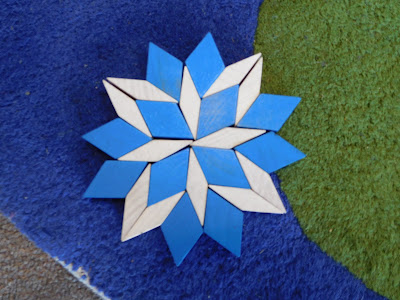They knew what I meant but I wanted them to clarify the concept anyway.
They told me:
- it needs to be a star shape
- it needs to be a pattern
- it is not a straight line - by this, they meant it is not linear but it is radial, not words they know (yet) but ones that we will introduce.
Once they had made some patterns I asked them what these patterns had in common and what they had that was different.
They told me:
- all star patterns are joining together in the middle - this was a great observation and will become the focus when we start talking about radial symmetry
- different stars can have different numbers of legs - another good observation. Some of the patterns we made had 4, 5, 6, 8, 10....legs.
Here are pictures of what they produced:
4-pointed star:
This started from the outside and moved inwards. It got a bit tricky when the pieces didn't fit neatly but the idea is there.
5-pointed star:
I liked this because, while 5-pointed stars are quite a common in nature, I wasn't sure that any of the students would come up with this.
6-pointed star:

The pattern blocks are good for this as they make good use of the hexagon as a basic shape.
7-pointed star:
This is one I really wasn't thinking I would see. You can see that it is difficult to make a pattern with seven as your base number but we made a good attempt.
8-pointed star that became 12-pointed:
This one seemed to grow by itself as the pattern radiated outwards.
10-pointed star:
This is unusual. It has symmetry but I'm not sure that is is perfectly radial. I think it gets back to the idea that the star needs to start at a point in the very centre.






Which grade are these students in?
ReplyDeleteHi Susan - these guys are Year 2 (7 years old turning 8 during the year).
ReplyDelete